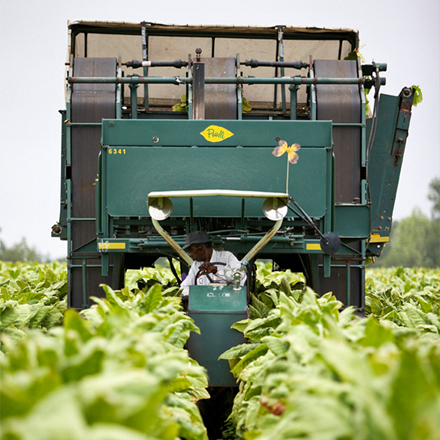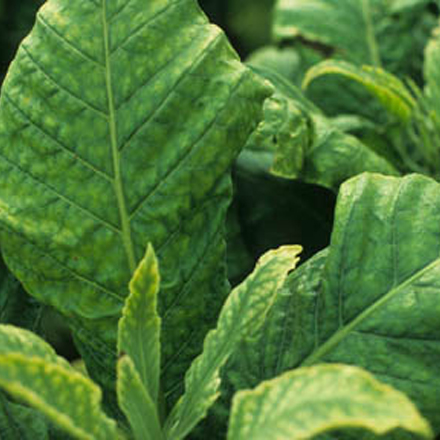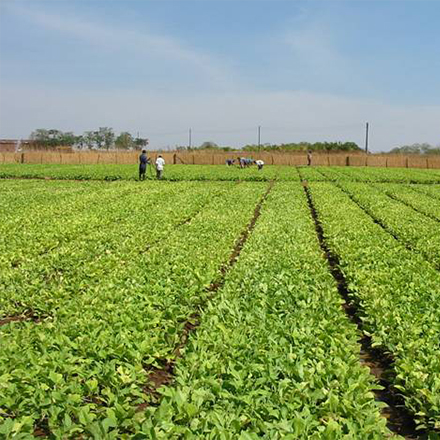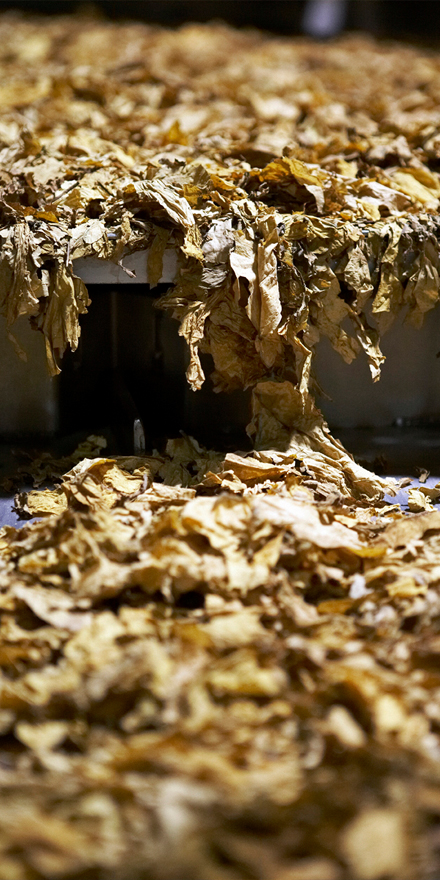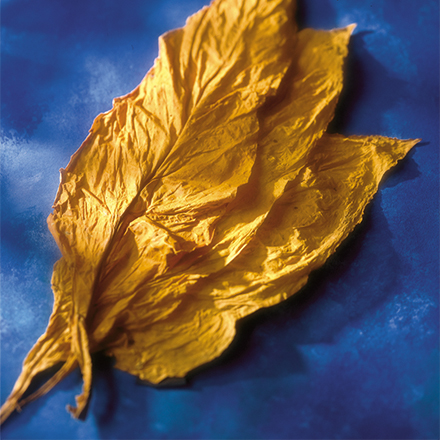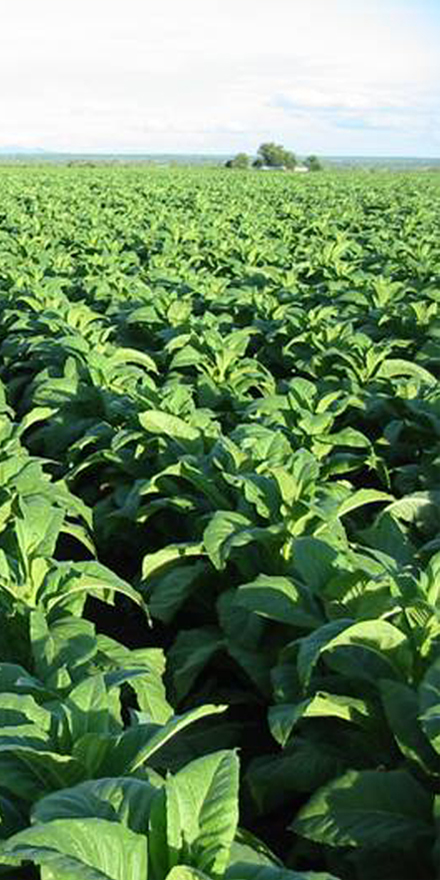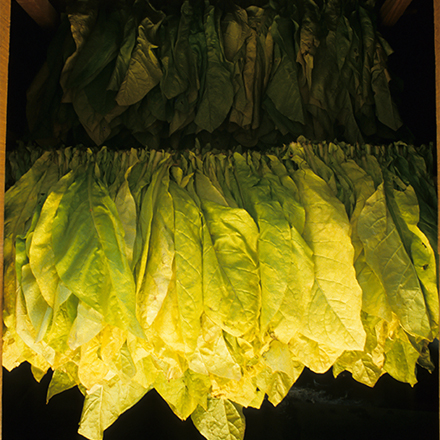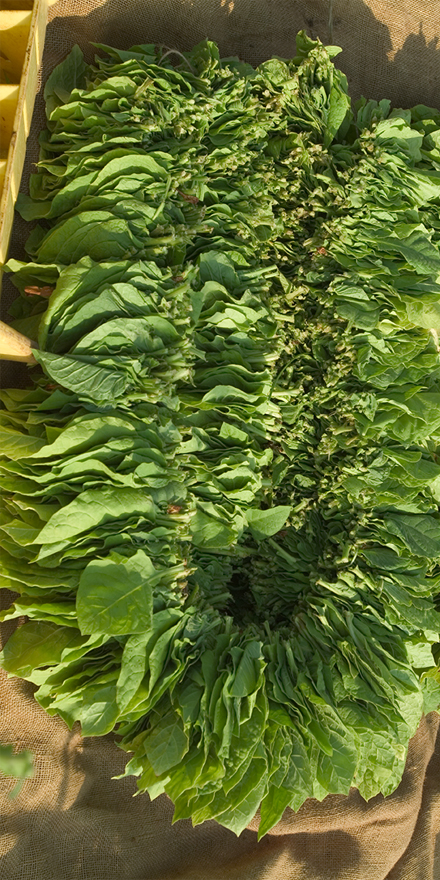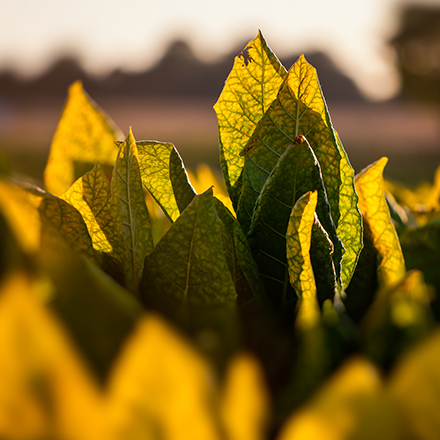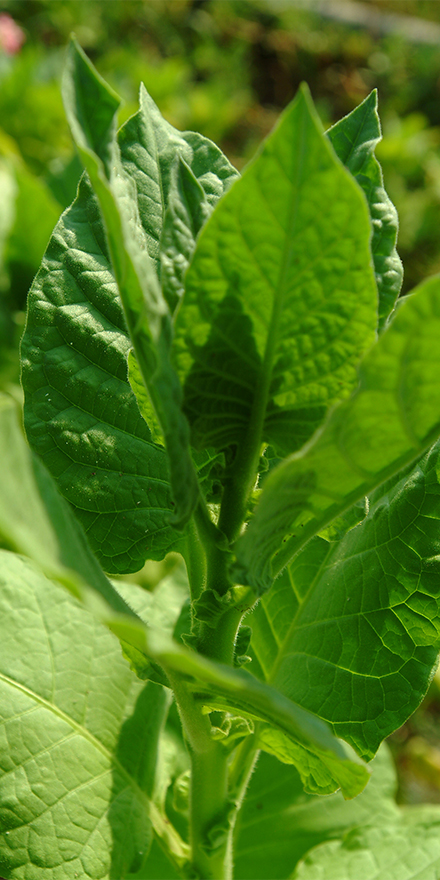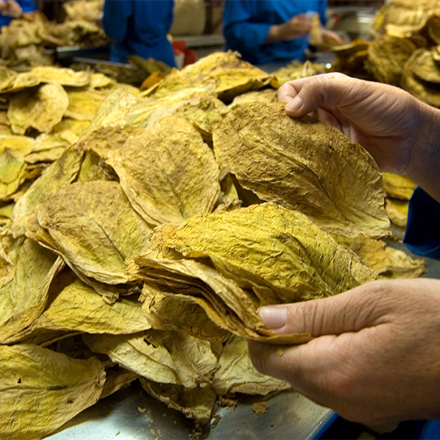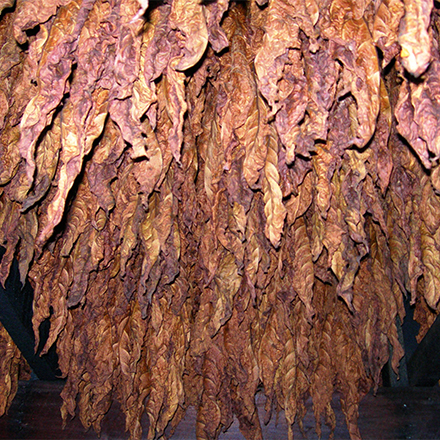Air-cured tobaccos are a group of tobacco types and sub-types that are typically cured in ventilated barns under natural atmospheric conditions with little to no supplemental heat added - only air. Air-cured tobaccos can be further divided into Dark Air-Cured (DAC) and Light Air-Cured (LAC) tobacco types. Air-cured tobaccos can either be primed harvested where individual leaves are removed from the growing plant as they mature and ripen in the field, or stalk-cut harvested where the entire plant is harvested at once by cutting the plant’s stalk at ground level with the leaves attached to the stalk. Depending upon the air-cured tobacco type and method of harvest, the air-curing process takes between three to twelve weeks and results in light tan to reddish-brown to deep brown leaf color. The primary LAC tobacco types are Burley and Maryland tobacco types. There are several different types and sub-types of DAC tobaccos grown around the world and this broad diversity allows them to be used in many different manufactured tobacco products such as American blend cigarettes, cigar, moist snuff, snus, chewing, Roll-Your-Own (RYO), Make-Your-Own (MYO), and water pipe products.
Burley is a type of Light Air-Cured tobacco typically cured in ventilated barns under natural atmospheric conditions with little to no supplemental heat added - only air. Burley is the second most popular tobacco type grown around the world. In general, Burley tobacco leaves are lighter green in color during growth, due to a lower chlorophyll content, and thinner compared to most other air-cured tobaccos and Flue-Cured tobacco types. Burley tobacco can either be primed harvested where individual leaves are removed from the growing plant as they mature and ripen in the field, or stalk-cut harvested where the entire plant is harvested at once by cutting the plant’s stalk at ground level with the leaves attached to the stalk. Burley curing takes between three to twelve weeks and results in light tan to reddish-brown leaf color. Burley is most commonly used in American blend cigarettes, Roll-Your-Own (RYO), and Make-Your-Own (MYO) products, but may be utilized in other manufactured tobacco products as well.
This Connecticut type is predominately grown for the sole purpose of wrapper for the cigar industry. Contrary to other tobacco crops in the U.S., it is sold on the open market after the farmer has prepared the bales for sale. The purchase price depends on the quality evaluations conducted on the individual farmer’s crop. The top quality grades have thick body, excellent oil, stretch, and absorb very well. These qualities produce premium maduro wrapper which inherently generate a slight sweet taste when consumed.
Protected from the sun by muslin shade cloth, this type produces a thin-bodied leaf for the premium cigar market. Top quality wrapper, without a blemish, is very expensive. This tobacco is manually sorted into many classifications and segregated according to quality. Characteristics of the leaf include good oil, stretch and absorption capacity. The smooth taste with the roundness of tobacco flavor, gives this tobacco its uniqueness.
Dark Air-Cured tobaccos are a diverse group of air-cured tobaccos typically cured in ventilated barns under natural atmospheric conditions with little to no supplemental heat added. DAC tobacco plants often have leaves that are darker green in color during growth, due to a high chlorophyll content, and thicker compared to Burley. DAC tobaccos can either be primed harvested where individual leaves are removed from the growing plant as they mature and ripen in the field, or stalk-cut harvested where the entire plant is harvested at once by cutting the plant’s stalk at ground level with the leaves stilled attached to the stalk. DAC curing takes between three to twelve weeks and results in light brown to deep brown leaf color. DAC tobaccos may be fermented or non-fermented depending upon the specific DAC type or sub-type and the manufactured tobacco product. DAC tobacco types as primarily used in cigar, moist snuff, snus, chewing tobacco, as well as in pipe, dark cigarettes, Roll-Your-Own (RYO), Make-You-Own (MYO), and water pipe products.
Dark Fired-Cured tobacco, also known as ‘Fire-Cured’, is often physiologically similar to some Dark Air-Cured tobacco types, however the curing process is significantly different. DFC tobacco plants often have leaves that are darker green in color during growth, due to a high chlorophyll content, and thicker compared to Burley and Flue-Cured Virginia. DFC tobacco can either be primed harvested where individual leaves are removed from the growing plant as they mature and ripen in the field, or stalk-cut harvested where the entire plant is harvested at once by cutting the plant’s stalk at ground level with the leaves stilled attached to the stalk. DFC tobacco is cured in an enclosed barn where small fires are typically built on the barn’s floor and the leaves cure in a smoke-laden environment. DFC tobacco is commonly cured with alternating periods of fire & smoke and air-curing. The duration of the respective fire & smoke and air-curing periods varies across DFC sub-types. DFC curing take from a week to eight weeks to complete and results in light brown to dark brown leaf color. DFC tobacco is traditionally used in moist snuff, snus, cigar, Roll-Your-Own (RYO), Make-Your-Own (MYO), chewing tobacco, and water pipe products.
Flue-cured Virginia tobacco, which is also known as Virginia Tobacco or Bright Leaf, is a type of tobacco that is cured using supplemental heat. Originally the heat was supplied into the curing barn via flue pipes (from which the name Flue-Cured Tobacco is derived) that heated the air to cure and dry the leaves. FCV tobacco plants commonly have leaves that are darker green in color during growth, due to a high chlorophyll content, and thicker compared to Burley, but normally lighter in color and thinner than Dark Fire-Cured and Dark Air-Cured tobacco types. FCV tobacco leaves are harvested by priming, where individual leaves are removed from the growing plant as they mature and ripen in the field. Harvested leaves are placed onto sticks or encased into racks or boxes for curing. As the leaves lose their moisture during curing, they develop their sweet aroma, texture, and color. Cured leaves typically range in color from a light yellow to a dark orange. FCV is mostly used in cigarettes, Roll-Your-Own (RYO), and Make-Your-Own (MYO) products, but may be utilized in other manufactured tobacco products as well.
Specializing in procuring USDA certified organic tobacco since 2008. The organic GROS has been specifically tailored to snus and other oral products. Since June 1, 2012, the EU and the USDA agreed to accept each other’s certification criteria as being equivalent; thus, making it easier to trade. The organic farmers do an excellent job of growing the tobacco and completing their paperwork to receive their accreditation. It takes three years for a farmer to convert the farm to organic and to be able to sell organically certified tobacco. They also incur the added costs of certification.
Oriental tobaccos, also known as ‘Turkish Tobacco’, are a group of related tobacco types and sub-types that are distinguished by their relatively small leaves, short plants, and aromatic qualities. Oriental tobaccos are typically grown in arid climates, which assists in maximizing the aromatic properties associated with these tobaccos. ‘Classical Oriental Tobaccos’ are historically produced in Greece and Turkey, and some adjacent countries, but other Oriental types and sub-types are grown in other distant countries. Oriental tobaccos are mainly primed harvested where individual leaves are removed from the growing plant as they mature and ripen in the field – starting with the lowest leaves and moving up the stalk over a five to nine week period. Freshly harvested leaves are normally sewn onto strings or sticks and cured in sun drenched frames, often with clear plastic coverings to increase heat and reduce water, from dews or rainfall, damage. Cured leaf ranges from yellow golden to light brown to light green. Oriental tobacco is typically used in cigarette products.
This dark air-cured variety is the same type grown in Tennessee, Kentucky and Virginia for many years. It has been grown in Pennsylvania since 2005 as a result of the abolishment of the governmental quota system. Since the inception of this type in 2005, it has become an integral component of the snus and moist snuff industry. Attractive characteristics include a thick bodied leaf with excellent absorption capacity.
This light air-cured type is predominately used in the cigarette industry across the globe. It is the same type that was used in Maryland when Maryland 609 was still being grown and available. When the market in Maryland disappeared for this type of tobacco, the 609 variety was brought next door to the Pennsylvania farmer base. In comparison, the PA/Maryland 609 is the closest replica to what Maryland 609 used to be. Characteristics include a thin to medium bodied leaf with good filling capacity which produces a nice, well rounded smoke.
This variety is a unique dark air-cured tobacco. The use of this variety spans over many tobacco products such as American chew, moist snuff, snus, cigars and dark cigarettes. Characteristics of the variety include impeccable absorption capacity, stretch ability, durability, a nonintrusive rich flavor orally and a nice smooth smoke on or in a cigar.
Sun-Cured tobaccos are a diverse group of tobacco types where the cured leaves are exposed to direct sunlight during the curing process. The curing process is highly variable across the numerous sun-cured tobacco types, from individual leaves being exposed in direct sunlight to freshly harvested leaves being chopped into a cut-rag and cured in direct sunlight on mats to clusters of leaves being sewed onto strings or sticks and cured on sun drenched frames. Many of the sun-cured types are local tobacco types specific to a given country with limited international trade, however Oriental tobaccos are a group of tobacco types and sub-types that are often referred to as sun-cured tobacco that have an important position in the international tobacco trade.
This type is predominately used in the moist snuff market. Other uses include the Egyptian water pipe, RYO, MYO, pipe and Italian style cigars. Wrapper tobacco is also hand selected at the farm level. As the name suggest, it is fire-cured with fire & smoke. The process of fire-curing entails four consecutive weeks of applying smoke from smoldering sawdust piled on hardwood slats. Characteristics of the leaf include thick body, oil, stretch and good absorption capacity.
This air-cured type is almost the same as the dark fire-cured tobacco from Tennessee and Kentucky without the smoke added during the curing process. It too is used predominately in the moist snuff market but also caters to the snus, RYO, MYO and Egyptian water pipe markets. The thick leaf typically carries oil, stretch and good absorption capacity.
The difference between Virginia dark fire-cured and Tennessee/Kentucky dark fire-cured is the Virginia receives much less smoke during curing. Therefore, the leaf gives off just a hint of the characteristic smoke smell. The body of the leaf is thick, tends to carry excellent oil and stretch and has very good absorption capacity. Traditional uses for this variety include moist snuff, Egyptian water pipe, RYO and wrapper for cigars.
Procured from Wisconsin, this dark air-cured type is predominately used in U.S. chew products. It has a pleasant neutral flavor and has excellent absorption capacity. It grows faster than other domestic types, thus making it a good choice for the shortened growing season in Wisconsin. Upon being received from the farmer, the tobacco is put in piles to sweat. After this initial sweating process, the tobacco is allowed to mellow for at least one year through a natural summer and winter sweat before being selected for use in a product.




